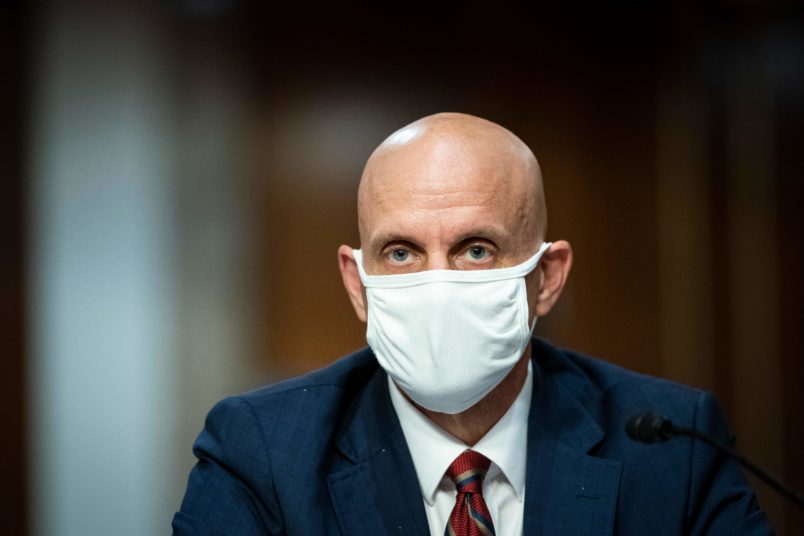YES THE IDIOT SAID THAT


HOUSTON, TEXAS - November 1, 2017: Houston Mayor Sylvester Turner at Houston City Hall. (Photo by Ilana Panich-Linsman for The Washington Post via Getty Images)
By Summer Concepcion
|
July 5, 2020
The mayors of two Texas metropolitan areas on Sunday expressed their dismay with President Trump’s false claim that 99% of coronavirus cases are “totally harmless.”
Texas is currently considered a coronavirus hotspot, along with Florida and Texas, as it recently recorded six straight days of confirmed new cases above 5,000. The Lone Star state reported a record daily increase of 8,258 coronavirus cases and 7,890 hospitalizations on Saturday.
On Thursday, Texas Gov. Greg Abbott (R) issued a statewide rule requiring masks to be worn in public, marking a whiplash-inducing reversal after he long resisted taking the firm measures that other COVID-ravaged states adopted in light of surges in coronavirus cases.
During a Fourth of July event at the White House South Lawn on Saturday, the President claimed, without evidence, that 99% of coronavirus cases are “totally harmless” thanks to testing almost 40 million people for the viral disease.
When pressed on Trump’s baseless claim the day before, the mayors of Houston and Austin highly disagreed with the President’s assertion.
Here’s what the Texas mayors had to say:
Houston Mayor Sylvester Turner
When asked whether the President’s baseless claim that 99% of COVID-19 cases are “totally harmless” holds up in Houston, Turner told CBS News’ Margaret Brennan that “no, that’s not the case.”
“I will tell you, a month ago one in 10 people were testing positive. Today, it’s one in four,” Turner said. “The number of people who are getting sick and going to the hospitals has exponentially increased. The number of people in our ICU beds has exponentially increased.”
Turner added that “if we don’t get our hands around this virus quickly,” Houston’s hospital system could be “in serious trouble” in about two weeks.
Watch Turner’s remarks below:
Houston Mayor Mayor Sylvester Turner says Trump's claim that 99% of coronavirus cases are "harmless" is "not the case” pic.twitter.com/uNproW8dLw
— Talking Points Memo (@TPM) July 5, 2020
Austin Mayor Steve Adler
Pressed on Trump’s false claim that 99% of coronavirus cases are “completely harmless” during an interview on CNN, Adler said that the President’s remark “makes me angry” and that it’s “dangerous not to be sending a clear message to Americans.”
“We have the July 4 weekend, and we need everybody wearing masks,” Adler said. “And when they start hearing that kind of ambiguous message coming out of Washington, there are more and more people that won’t wear masks, that won’t social distance, that won’t do what it takes to keep a community safe.”
Adler argued that the President’s messaging is “wrong” and “dangerous.”
“I just have to hope that people aren’t going to listen to that, and they will stay focused on what they’re hearing here more locally,” Adler said, before adding that Austin is “standing ready” for another stay-at-home order due to being on a trajectory showing that intensive care units could be inundated within the next week.
Watch Adler’s remarks below:
Austin Mayor Steve Adler says Trump's claim that 99% of coronavirus cases are "harmless" makes him "angry" pic.twitter.com/7wDN5UoGXl
— Talking Points Memo (@TPM) July 5, 2020
Are ‘Harmless’
Stephen Hahn, commissioner of food and drugs at the US Food and Drug Administration (FDA), wears a protective covering during a Senate Health, Education, Labor and Pensions Committee hearing in Washington, DC, on Jun... MORE
TPM’s COVID-19 hub.
Josh Marshall’s Twitter List of Trusted Experts (Epidemiologists, Researchers, Clinicians, Journalists, Government Agencies) providing reliable real-time information on the COVID-19 Crisis.
COVID-19 Tracking Project (updated data on testing and infections in the U.S.).
Johns Hopkins Global COVID-19 Survey (most up to date numbers globally and for countries around the world).
Worldometers.info (extensive source of information and data visualizations on COVID-19 Crisis — discussion of data here).

Summer Concepcion is a newswriter for TPM based in New York. She previously covered the 2016 election for Fusion, conducted investigative research for The Nation Institute, and has written for NBC Chicago and the Chicago Reader.
By Summer Concepcion
|
July 5, 2020
The mayors of two Texas metropolitan areas on Sunday expressed their dismay with President Trump’s false claim that 99% of coronavirus cases are “totally harmless.”
Texas is currently considered a coronavirus hotspot, along with Florida and Texas, as it recently recorded six straight days of confirmed new cases above 5,000. The Lone Star state reported a record daily increase of 8,258 coronavirus cases and 7,890 hospitalizations on Saturday.
On Thursday, Texas Gov. Greg Abbott (R) issued a statewide rule requiring masks to be worn in public, marking a whiplash-inducing reversal after he long resisted taking the firm measures that other COVID-ravaged states adopted in light of surges in coronavirus cases.
During a Fourth of July event at the White House South Lawn on Saturday, the President claimed, without evidence, that 99% of coronavirus cases are “totally harmless” thanks to testing almost 40 million people for the viral disease.
When pressed on Trump’s baseless claim the day before, the mayors of Houston and Austin highly disagreed with the President’s assertion.
Here’s what the Texas mayors had to say:
Houston Mayor Sylvester Turner
When asked whether the President’s baseless claim that 99% of COVID-19 cases are “totally harmless” holds up in Houston, Turner told CBS News’ Margaret Brennan that “no, that’s not the case.”
“I will tell you, a month ago one in 10 people were testing positive. Today, it’s one in four,” Turner said. “The number of people who are getting sick and going to the hospitals has exponentially increased. The number of people in our ICU beds has exponentially increased.”
Turner added that “if we don’t get our hands around this virus quickly,” Houston’s hospital system could be “in serious trouble” in about two weeks.
Watch Turner’s remarks below:
Houston Mayor Mayor Sylvester Turner says Trump's claim that 99% of coronavirus cases are "harmless" is "not the case” pic.twitter.com/uNproW8dLw
— Talking Points Memo (@TPM) July 5, 2020
Austin Mayor Steve Adler
Pressed on Trump’s false claim that 99% of coronavirus cases are “completely harmless” during an interview on CNN, Adler said that the President’s remark “makes me angry” and that it’s “dangerous not to be sending a clear message to Americans.”
“We have the July 4 weekend, and we need everybody wearing masks,” Adler said. “And when they start hearing that kind of ambiguous message coming out of Washington, there are more and more people that won’t wear masks, that won’t social distance, that won’t do what it takes to keep a community safe.”
Adler argued that the President’s messaging is “wrong” and “dangerous.”
“I just have to hope that people aren’t going to listen to that, and they will stay focused on what they’re hearing here more locally,” Adler said, before adding that Austin is “standing ready” for another stay-at-home order due to being on a trajectory showing that intensive care units could be inundated within the next week.
Watch Adler’s remarks below:
Austin Mayor Steve Adler says Trump's claim that 99% of coronavirus cases are "harmless" makes him "angry" pic.twitter.com/7wDN5UoGXl
— Talking Points Memo (@TPM) July 5, 2020
FDA Chief Won’t Refute Trump’s Claim That 99% Of Coronavirus Cases
Are ‘Harmless’

Stephen Hahn, commissioner of food and drugs at the US Food and Drug Administration (FDA), wears a protective covering during a Senate Health, Education, Labor and Pensions Committee hearing in Washington, DC, on Jun... MORE
By Summer Concepcion
|
July 5, 2020 10:08 a.m.
FDA commissioner Stephen Hahn on Sunday wouldn’t push back on President Trump’s baseless claim that 99% of coronavirus cases are “totally harmless” during a Fourth of July event at the White House South Lawn.
On Saturday, the President said, without evidence, that due to testing almost 40 million people for the coronavirus, “we show cases, 99% of which are totally harmless.”
When CNN’s Dana Bash pressed Hahn on Trump’s comment the following morning, Hahn acknowledge the surging coronavirus cases in the country, but said that “it’s too early” and won’t “speculate on what the causation is there.”
After Hahn said that “the way out of this” is for all Americans is to follow the CDC and the White House Coronavirus Task Force’s guidelines, Bash circled back to the question of how Hahn feels about Trump’s baseless claim that 99% of coronavirus cases are “totally harmless” as a member of the task force.
“I totally support the CDC and the information that they’re putting out with respect to this pandemic. I think it’s, again, really important,” Hahn said. “The guidelines that we’ve emphasized, the data that we have — again, it’s a rapidly evolving situation and we’re going to have more data. But we absolutely must take this seriously. We must institute these public health measures. We cannot back off from those. It’s a critically important for Americans to follow those guidelines and to protect the most vulnerable.”
Pressed again on Trump’s false claim, Hahn responded that he’s “not going to get into who is right and who is wrong.”
“What I’m going to say, Dana, is what I’ve said before: it’s a serious problem that we have,” Hahn said. “We’ve seen the surge in cases. We must do something to stem the tide, and we have this in our power to do this by following the guidance from the task force and the CDC.”
When Bash asked Hahn why he won’t say whether Trump’s claim was true or false, Hahn said that the White House Coronavirus Task Force has data showing “this is a serious problem” that “people need to take it seriously.”
Watch Hahn’s remarks below:
FDA commissioner Stephen Hahn won't say Trump is wrong when he claimed that 99% of coronavirus cases are "totally harmless" pic.twitter.com/GKaTnTdEnt
— Talking Points Memo (@TPM) July 5, 20
Key Coronavirus Crisis Links
Josh Marshall’s Twitter List of Trusted Experts (Epidemiologists, Researchers, Clinicians, Journalists, Government Agencies) providing reliable real-time information on the COVID-19 Crisis.
COVID-19 Tracking Project (updated data on testing and infections in the U.S.).
Johns Hopkins Global COVID-19 Survey (most up to date numbers globally and for countries around the world).
Worldometers.info (extensive source of information and data visualizations on COVID-19 Crisis — discussion of data here).

Summer Concepcion is a newswriter for TPM based in New York. She previously covered the 2016 election for Fusion, conducted investigative research for The Nation Institute, and has written for NBC Chicago and the Chicago Reader.








